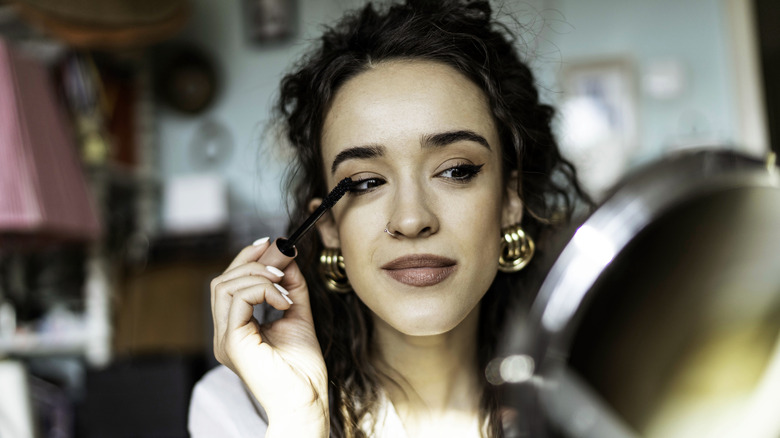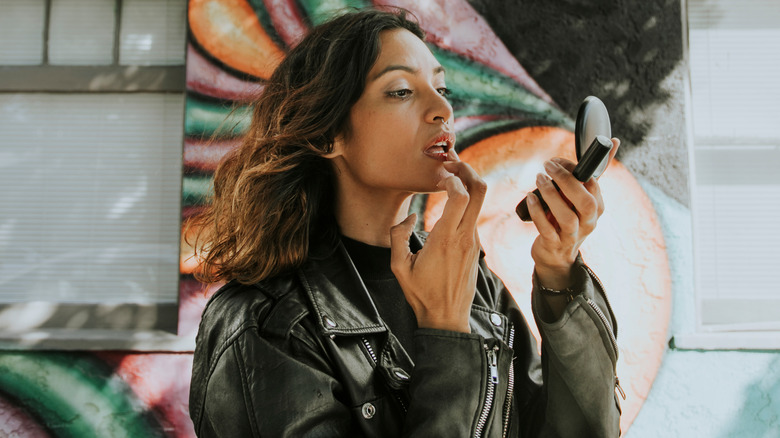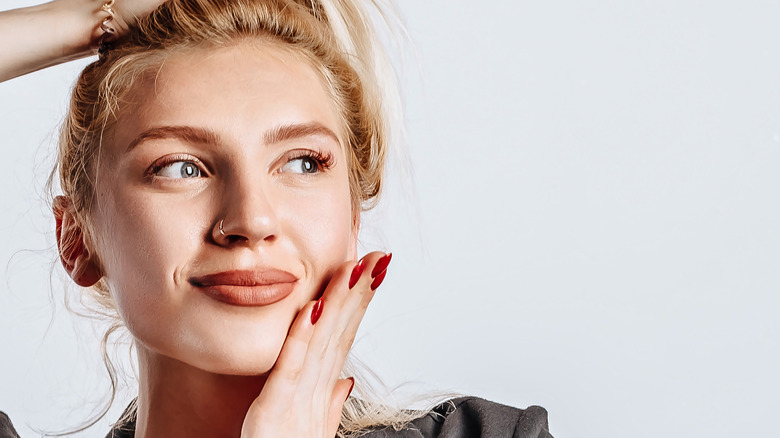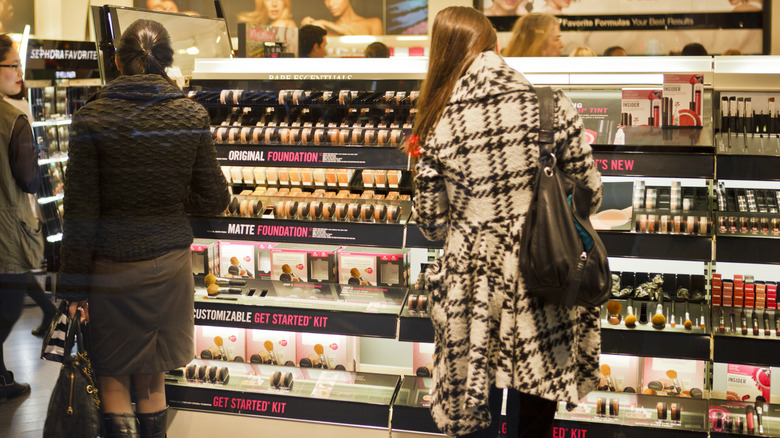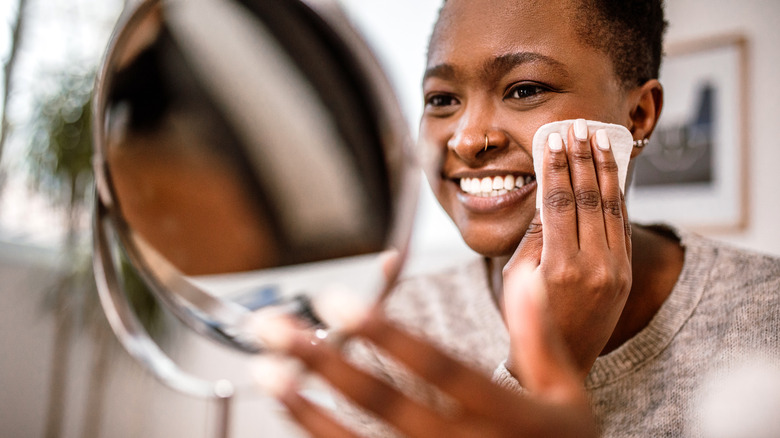5 Of Our Best Tips For Doing Makeup When You Have Facial Piercings
We may receive a commission on purchases made from links.
Nothing can be worse than poking and prodding around facial piercings while trying to do your makeup. While this year has been occupied with ways to perfectly curate earring stacks or learn what keloids are, there's a lot that goes into maintaining piercings (and avoiding them when they get in your way). More specifically, facial piercings — like those on your nose, lips, and eyebrows — can get in the way of daily practices like washing your face, applying makeup, and even blowing your nose during a cold.
When it comes to applying makeup on a face heavy with piercings, there are a few ways to get around the intrusions and achieve the look you're working towards. Before getting started, it's always best to avoid the makeup application process freshly after getting a new piercing. The skin on our faces is highly sensitive, which means giving our personalized accessories time to heal is essential. We've collected all the information you need to guide you through applying makeup with facial piercings. Once you conquer these techniques, your piercings will likely no longer be an issue.
Make sure applicators are clean
One of the most essential tips when it comes to applying makeup to a pierced face is keeping our applicators clean. According to makeup artist Alex Sanchez, appropriate makeup brushes and their hygiene are extremely important when it comes to facial piercings. "You need flat, small brushes to work around the jewelry," he explained to Makeup.com. "I also recommend synthetic brushes, because they can easily be cleaned and dried rapidly for daily use around these open areas to help avoid infections."
With fine-tip brushes, it's easier to apply makeup precisely and with more focus. Once these brushes are used several times, they should be thoroughly cleaned and dried to avoid any buildup of bacteria. With smaller brushes, you'll be less overwhelmed keeping them clean and will avoid infecting your piercing with toxins that can grow keloids and other infections. In addition, if something goes wrong, a smaller and softer brush will feel significantly less painful.
Lipstick for lip piercings
The trickiest piercing to avoid: lips. When it comes to lip color application, there are a few ways to avoid irritating the lips. To make sure every area of the lip is covered, use a lipstick liner to fill in sensitive spots before going over with a gloss or lipstick. Fine-line applicators like Q-tips, dove foot applicators, and lipstick brushes can help fill in areas that are hard to catch with thick strokes. It will also be to your benefit to use a long-lasting lip shade, since you'll want to avoid reapplication.
It can also be helpful to apply a concealer base to the lips before going in with color, as that will ensure the least likelihood of reapplication. Once the concealer has filled the lip — with help from a Q-tip or angled brush — follow through with the lipstick or gloss of your choice. You'll want to avoid the instinct to rub your lips together, as that can add pressure to the piercing and cause pain. We're going for the least pain possible here!
Using fingertips and light applicators
In speaking about the least painful way to apply makeup over piercings, it may also be beneficial to use your fingers to dab, wipe, and spread the lip color. You might be familiar with blotting your lips while applying lipstick or using foundation as the key to smudge-free lipstick, but lightweight application tools are often left behind. Per L'Oreal Paris USA, using a finger is also great to reach sensitive contour spots, like the bridge of your nose or cupid's bow. You can use another clean finger to wipe up any traces or smudges of makeup. Using your fingers will also help identify which parts of your face are most sensitive, so you know where to stay away from.
In addition to finger application, lightweight tools like Q-tips, mascara combs, fine brushes, and double-sided eyeshadow applicators are great alternatives to keep makeup contained from spreading. If you don't know where to get started on a good product for precise application, Lancome's Matte Shakers ($5-$30) are a favorite of professional makeup artists.
Products to avoid
There aren't too many ways to go wrong when it comes to selecting makeup products, but there are a few ones to avoid when it comes to facial piercings. For example, powders should be avoided completely since they're made up of small molecules that can easily enter hollow piercings. In addition, large brushes and beauty blenders that require a sweeping motion for application are also harmful to new piercings. Without realizing it, you may be susceptible to infection by being too harsh, quick, or intense on sensitive skin.
During the process of makeup removal, skin is even more susceptible to being pulled and irritated in unexpected ways. Avoid using an exfoliating tool to clean skin, but rather an antibacterial wash that can be applied with gentle hands. Although makeup wipes are not ideal for cleaning skin, they can help tackle corners of the face and skin around the piercing. Use a wipe to tackle the crevices of the nose, lips, and eyebrows, then follow up with a gentle antiseptic face wash to clean the rest of the face.
Removing makeup
Diving further into the makeup removal process, it's important to go in with gentle hands and techniques. Once you've cleaned sensitive areas with a makeup wipe, apply water to face and begin scrubbing gently and in circular motions. If possible, trace over sensitive areas with one finger and rinse thoroughly. Use a clean towel to pat your face dry, avoiding rubbing and other harsh pulling of the skin. Follow up with your typical skin care routine, with an additional jelly or ointment for your piercing.
In addition, micellar water and a cotton pad can act as a better alternative to makeup wipes (especially for those of us with extremely sensitive skin). For nose, eyes, and lips, apply micellar water to a clean cotton pad or q-tip and trace over crevices. Make sure makeup removal is followed up with products that have effectively proven to improve your skin, as your piercing will need all the help it can get when it comes to soothing the wound. With these tips in mind, your skin will thank you for your new and improved makeup application process.

